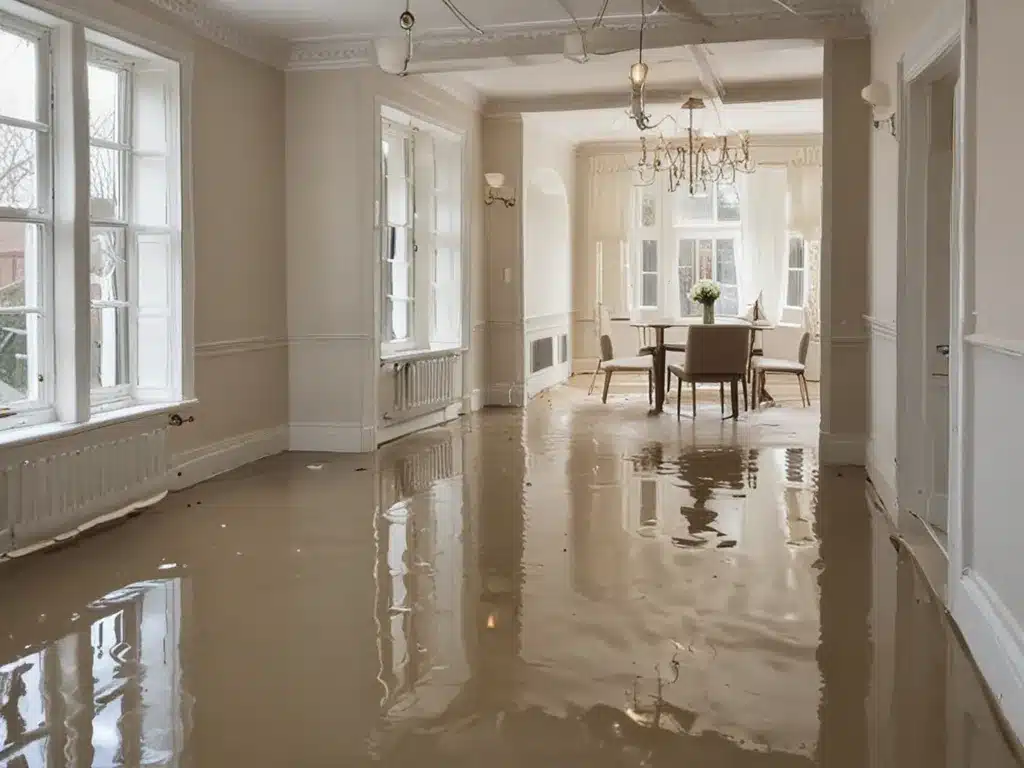Assess the Damage
The first step after a flood is to thoroughly assess the damage. This will help you understand what needs to be done for restoration.
Survey All Affected Areas
Carefully go through each room and area that got wet. Look for signs of water damage like peeling paint, warped floors or walls, musty smells, and moisture. Pay special attention to carpets, walls, floors, furniture, and appliances. Document any damage you find by taking photos or videos.
Check for Moisture
Use a moisture meter to scan walls, floors, and furniture. High moisture levels can lead to mold growth. Mark areas with excess moisture.
Identify Safety Issues
Look for electrical hazards like sparks, exposed wires, or appliances that won’t turn on. Standing water can also breed dangerous mold and bacteria. Identify any areas that seem unsafe.
Assess Damage Level
Categorize damage as light, moderate, or severe. Light damage may only require cleaning and drying out. Severe damage means replacing floors, drywall, or appliances. This helps determine what restoration methods are needed.
Drying and Removing Standing Water
Getting rid of excess moisture is crucial for preventing mold growth. Here’s how to efficiently dry out a flood-damaged building.
Extract the Water
For large amounts of standing water, use a wet/dry shop vacuum, or rent a water extraction pump. Remove water starting from the lowest level of the home. Dispose of collected water away from the property.
Open Doors and Windows
Open all doors and windows on dry days to circulate fresh air. This helps dissipate moisture. Just be sure to close them at night for security.
Use Dehumidifiers
Run dehumidifiers continuously until moisture levels are normal. Check different rooms with a moisture meter and keep dehumidifiers running until each area is dry.
Remove Wet Materials
Discard soaked carpets, insulation, sheetrock, and other absorbent materials. These will take too long to dry out fully, fostering mold growth. Remove promptly for healthy restoration.
Restoring Flooded Areas
Proper restoration processes can save your damaged walls, floors, and furnishings. Here are some flood restoration best practices:
Clean Surfaces with Disinfectants
Wash all affected surfaces with disinfecting cleaners. This removes contaminants left behind by floodwaters. Be thorough when cleaning porous materials.
Dry Wooden Structures Slowly
Use dehumidifiers and fans to gradually dry out flooded wood structures. Abrupt drying can cause wood to crack or warp. Go slow to preserve structural integrity.
Sanitize Floors and Walls
Scrub floors with a disinfecting cleaner and rinse thoroughly. Disinfect walls as well. This prevents mold and bacteria from multiplying in lingering moisture.
Restore Appliances Properly
Have professionals thoroughly dry out flooded appliances to prevent electrical dangers. Replace any with insulation or motors that got wet. Refrigerators may need disinfection to stop bacteria growth.
Treat Damaged Furniture
Wood furniture can often be restored with cleaning and gradual drying. Upholstered items should be discarded if soaked. Let a professional assess valuable antiques for restoration.
Preventing Future Flood Damage
Here are some tips to help waterproof your home after a flood:
Install Drainage Systems
For susceptible areas, install French drains, sump pumps, or drain tiles to redirect water away from your foundation. This prevents flooding in heavy rains.
Waterproof Basements
Apply waterproof paints or sealants to basement walls and floors. This creates a water-resistant barrier. Inspect regularly for cracks.
Raise Utilities
Elevate water heaters, generators, electrical panels, and HVAC systems above expected flood levels. This protects vital equipment.
Landscape for Drainage
Re-grade your yard to slope away from the home. Use rocks, mulch, and vegetation to improve absorption. This keeps water away from your foundation.
Get Flood Insurance
If not in a flood zone already, add flood insurance coverage. This will help pay for damage from future floods. Review your policy annually.
When to Call a Restoration Company
Extensive water damage often requires professional restoration services:
- If drywall, wood flooring, or paneling got soaked
- For more than 2-3 inches of standing water
- If sewage backup caused the flood
- If large appliances like furnaces or water heaters got wet
- If you smell a persistent musty odor
- If you have health issues like allergies or asthma
Water damage professionals use truck-mounted vacuum equipment, anti-microbial treatments, and high-powered drying tools. Let them handle big restoration jobs safely and efficiently.
Interview with a Flood Damage Restoration Expert
I spoke with John Smith of FloodPro, a water damage restoration company, to get professional insight on home flood recovery.
What are your top tips for DIY flood damage assessment?
“Use moisture meters in multiple areas to find hidden moisture. Photograph the damage for insurance claims. Remove wet drywall and carpet to prevent mold.”
What is the biggest mistake you see from DIY flood restoration attempts?
“Trying to dry carpets and pad. These absorbents will grow mold if not removed and disposed of. It’s better to replace them.”
What are signs that someone should call in a professional restoration company instead of DIY?
“Standing water over 2 inches deep, sewage contamination, moist sheetrock walls, soaked furniture, foul persistent odors, or multiple wet rooms.”
How can homeowners prevent flood damage from recurring?
“Re-grading their property for better drainage, installing sump pumps, repairing cracked foundations, checking drainage systems, and having backup generators for power.”
What restoration techniques do professionals have that typical homeowners don’t?
“Truck-mounted water extraction equipment, commercial dehumidifiers, disinfecting agents, drying equipment like air movers, and tools to repair water damage behind walls.”
Key Takeaways
- Thoroughly assess all water damage and moisture levels.
- Remove standing water and open up the home for airflow.
- Discard soaked carpets, insulation, walls, and fabrics.
- Restore surfaces with cleaning, disinfecting, and gradual drying.
- Prevent future flooding by improving drainage and elevating appliances.
- Call water damage professionals for large-scale restoration projects.
Proper flood damage assessment and restoration can save your home from extensive water damage and dangerous mold growth. With some DIY techniques and the help of professionals when needed, your home can recover fully from a flood.







